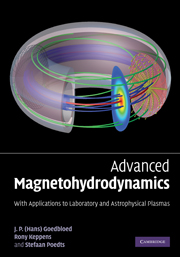14 - Resistive plasma dynamics
Published online by Cambridge University Press: 05 March 2013
Summary
Plasmas with dissipation
Conservative versus dissipative dynamical systems
We have already come across the enormous difference between conservative (ideal) MHD and dissipative (resistive, viscous, etc.) MHD in Volume [1], Chapter 4. This difference runs through all of classical dynamics of discrete and continuous media. It involves quite different physical assumptions and corresponding different mathematical solution techniques. An instructive example is spectral theory (Volume [1], Chapter 6) which is classical, consistent and misleadingly beautiful for ideal MHD, but full of unresolved problems in resistive MHD. The classical part concerns self-adjoint linear operators in Hilbert space, analogous to quantum mechanics, and stability analysis by means of an energy principle. When dissipation is important, precisely these two “sledge hammers” are missing in the dynamical systems workshop. Even the definition of what is an important, i.e. physically dominant, contribution to the dynamics deserves extreme care. This is best illustrated by the general description of the dynamics of ordinary fluids which is fundamentally different for ideal fluids, characterised by an infinite Reynolds number, and viscous fluids, characterised by a finite Reynolds number. This is even so for extremely large Reynolds numbers, in a certain sense irrespective of how large this number is. Viscous boundary layers always arise in real fluids. This qualitative difference between ideal and dissipative dynamics, with the occurrence of boundary layers, also applies to MHD when resistivity is introduced.
- Type
- Chapter
- Information
- Advanced MagnetohydrodynamicsWith Applications to Laboratory and Astrophysical Plasmas, pp. 127 - 176Publisher: Cambridge University PressPrint publication year: 2010



